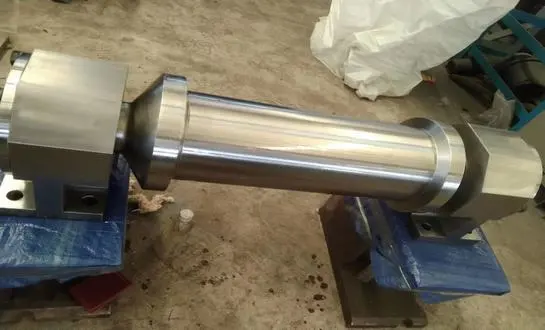How Do Tension Rolls Ensure Precision in Steel Coil Processing?
The precision ensured by tension rolls in steel coil processing is a result of their sophisticated design and strategic implementation within the production line. These rolls are engineered to apply and maintain a specific amount of tension to the steel strip, which is critical for achieving uniform thickness and surface quality.
Tension Control Mechanisms
Modern tension roll systems employ advanced control mechanisms that continuously adjust the applied tension based on real-time feedback. This dynamic tension control allows for immediate responses to variations in material properties or processing conditions, ensuring consistent quality throughout the entire length of the steel coil.
Surface Quality Enhancement
By maintaining optimal tension, these rolls help prevent surface defects such as scratches, dents, or waviness that can occur when the steel strip is not properly supported or tensioned. The smooth, controlled contact between the roll surface and the steel ensures a high-quality finish, which is particularly important for industries demanding impeccable surface characteristics, such as automotive manufacturing.
Dimensional Accuracy
Tension rolls contribute significantly to the dimensional accuracy of processed steel coils. By maintaining consistent tension, they help control the strip's width and thickness, ensuring that the final product meets stringent dimensional tolerances. This precision is crucial for downstream processes and applications where exact measurements are non-negotiable.
Tension Roll Systems: Types, Applications, and Efficiency in Steel Processing
The diversity of tension roll systems available today reflects the complex demands of modern steel processing. Each type of tension roll system is designed to address specific processing requirements, material properties, and production goals.
Types of Tension Roll Systems
1. Pneumatic Tension Rolls: These utilize air pressure to adjust and maintain tension, offering smooth operation and quick response to tension changes.
2. Hydraulic Tension Rolls: Providing high force capabilities, hydraulic systems are ideal for heavy-duty applications requiring precise tension control.
3. Electric Servo-Driven Rolls: Offering the highest level of precision and control, these systems use electric servo motors for rapid and accurate tension adjustments.
Applications Across Industries
Tension rolls find applications in various sectors beyond traditional steel manufacturing:
- Automotive Industry: In the production of high-strength steel sheets for vehicle bodies, tension rolls ensure uniform material properties crucial for safety and performance.
- Construction: For manufacturing steel profiles and structural elements, tension rolls help maintain consistent dimensions and surface quality.
- Electronics: In the production of thin steel sheets used in electronic components, precision tension control is essential for maintaining tight tolerances.
Efficiency Improvements
The implementation of advanced tension roll systems has led to significant efficiency improvements in steel processing:
- Reduced Material Waste: Precise tension control minimizes the occurrence of defects, reducing scrap rates and improving material utilization.
- Increased Production Speeds: Modern tension roll systems allow for higher processing speeds without compromising quality, boosting overall productivity.
- Energy Efficiency: By optimizing the tension applied, these systems can reduce the overall energy consumption of the processing line.
Tension Rolls: Key Functions and Maintenance for Optimal Steel Coil Production
Understanding the key capacities of pressure rolls and actualizing legitimate support hones are basic for accomplishing ideal steel coil generation. These components are not merely detached components in the generation line; they effectively contribute to the quality and productivity of the whole process.
Key Functions of Tension Rolls
1. Strip Stabilization: Tension rolls stabilize the steel strip as it moves through the processing line, preventing unwanted movement or vibration that could lead to defects.
2. Wrinkle Prevention: By maintaining proper tension, these rolls prevent the formation of wrinkles or creases in the steel strip, especially during direction changes or in accumulator sections.
3. Tension Distribution: They help distribute tension evenly across the width of the steel strip, which is crucial for maintaining consistent material properties and dimensions.
4. Speed Regulation: In conjunction with drive systems, tension rolls assist in regulating the speed of the steel strip through different sections of the processing line.
Maintenance Practices for Longevity and Performance
Regular maintenance of tension rolls is crucial for ensuring their optimal performance and longevity:
- Surface Inspection: Regular visual and tactile inspections of roll surfaces can detect early signs of wear, scoring, or other damage that could affect performance.
- Alignment Checks: Periodic alignment checks and adjustments ensure that tension rolls remain perfectly aligned with the processing line, preventing uneven wear and tension distribution.
- Bearing Maintenance: Proper lubrication and monitoring of bearing conditions are essential for smooth operation and preventing unexpected downtime.
- Cleaning Protocols: Implementing regular cleaning procedures removes debris and contaminants that could affect the roll's surface quality or performance.
Advancements in Tension Roll Technology
Recent advancements in tension roll technology have further enhanced their capabilities:
- Smart Sensors: Integration of smart sensors allows for real-time monitoring of roll performance, tension levels, and early detection of potential issues.
- Advanced Materials: Development of new roll surface materials and coatings has improved durability and reduced the frequency of maintenance interventions.
- Adaptive Control Systems: Implementation of AI-driven adaptive control systems enables tension rolls to automatically adjust to varying processing conditions, optimizing performance across different steel grades and thicknesses.
Conclusion
In conclusion, the part of pressure rolls in steel coil handling cannot be exaggerated. These basic components guarantee exactness, quality, and effectiveness all through the generation handle. From keeping up steady pressure to anticipating surrenders and empowering high-speed preparing, pressure rolls are at the heart of present-day steel fabricating. As innovation proceeds to development, we can anticipate assisting developments in the pressure roll plan and usefulness, driving indeed more prominent changes in steel coil preparing effectiveness and quality. For those looking to optimize their steel handling operations, understanding and leveraging the capabilities of advanced pressure roll frameworks is key to remaining competitive in today's demanding market. For more information on tension rolls and other critical components in steel processing, please contact us at oiltools15@welongpost.com. Welong is committed to providing cutting-edge solutions for all your steel processing needs.





